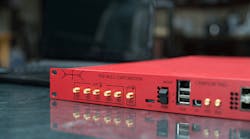This file type includes high resolution graphics and schematics when applicable.
Software-defined radios (SDRs) offer the potential to be all things to all people. With sufficient bandwidth and processing power, a single SDR can serve almost any application within its frequency range, from commercial communications to military radar and test equipment. The Crimson TNG (“The Next Generation”) from Per Vices Corporation is designed to be that single-SDR solution for applications from DC to 6 GHz.
This SDR packs high-speed analog-to-digital converters (ADCs), digital-to-analog converters (DACs), and a good amount of computer processing power into a compact 1U-high rack-mount enclosure. As a receiver, it can digitize input signals quickly and accurately. As a transmitter, it can generate output waveforms with wideband modulation using four receive and four transmit channels—each with as much as 322 MHz bandwidth—for a total RF bandwidth of more than 1,200 MHz.
The Crimson TNG SDR (see figure) is a true single radio solution for modern communications systems, including Third-Generation (3G), Fourth-Generation (4G), and even proposed Fifth-Generation (5G) cellular radio standards. It is also capable of operating within signal intelligence (SIGINT) systems, commercial and military radar systems, and test-and-measurement applications. Each of its multiple receive and transmit channels can be independently controlled, allowing the SDR to perform such functions as scanning for signals while transmitting a wide variety of modulated waveforms.
The SDR is capable of phase-coherent operation of all four transmit and all four receive channels for implementation of phase-modulated signal formats with in-phase (I) and quadrature (Q) signal components. Software support enables automatic phase calibration of the four receive and transmit channels, as well as automatic calibration of I and Q amplitude and phase imbalances, using finite-impulse-response (FIR) filtering.
The high-performance SDR is based on high-quality components, including two model DAC38J84 quad-channel DACs and four model ADC16DX370 dual-channel, 16-b ADCs from Texas Instruments, along with a model 5ASTMD3E3F31I3N Arria V field-programmable gate array (FPGA) system-on-chip (SoC) from Altera Corp. The FPGA SoC has an on-chip dual-core ARM Cortex-A9 microprocessor and web-based interface to simplify access to and remote control of the SDR. The high-speed FPGA supports transceiver applications to 3.125 GSamples/s, but features an energy-efficient circuit design to conserve power. The radio’s integral FPGA and built-in microprocessor combine for programmable flexibility in orchestrating almost any modulation format—even for wireless standards, such as 5G, that are still in their formative stages.
The SDR housing measures 482.6 × 500 × 43.69 mm and weighs 5.4 kg. The direct-conversion transceiver derives excellent frequency accuracy from an internal 10-MHz oven-controlled crystal oscillator (OCXO) frequency reference with ±5-ppb stability. The SDR supports its digital components with excellent analog front-end filtering with high isolation and rejection of out-of-band signals on the receive side and suppression of spurious signal content on the transmit side.
The Crimson TNG is a flexible radio solution for multiple-standard wireless systems, yet also offers the capability for spectrum monitoring, as well as signal generation and analysis in test systems. It includes an Internet interface and UHD compatibility for ease of data transport. The radio’s dual small-form-factor-pluggable (SFP+) wireless backhaul connections provide data transfer speeds to 20 Gb/s for low latency and near real-time monitoring of radio spectrum. In addition, the company provides fast-turnaround custom wireless platforms to meet specific applications.
Per Vices Corporation, 2440 Dundas St West, Unit 204, Toronto, Ontario, Canada M6P 1W9; (647) 534-9007
Looking for parts? Go to SourceESB.
This file type includes high resolution graphics and schematics when applicable.


